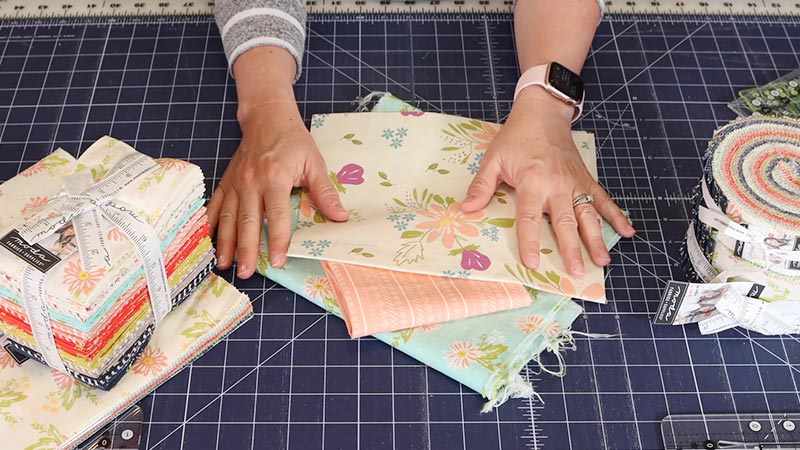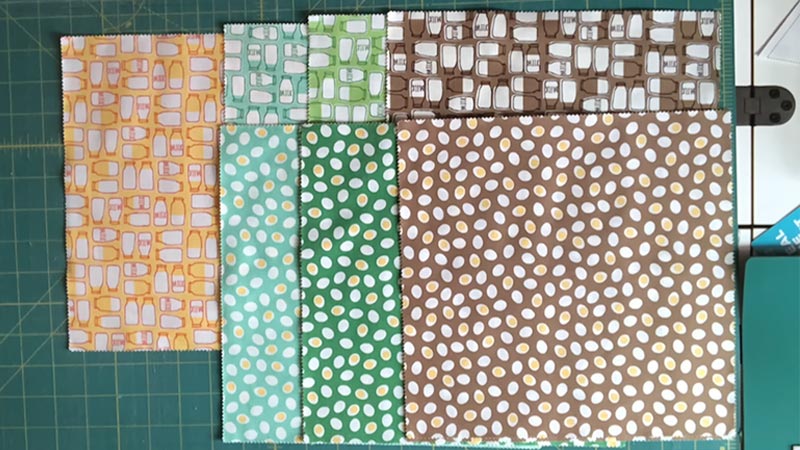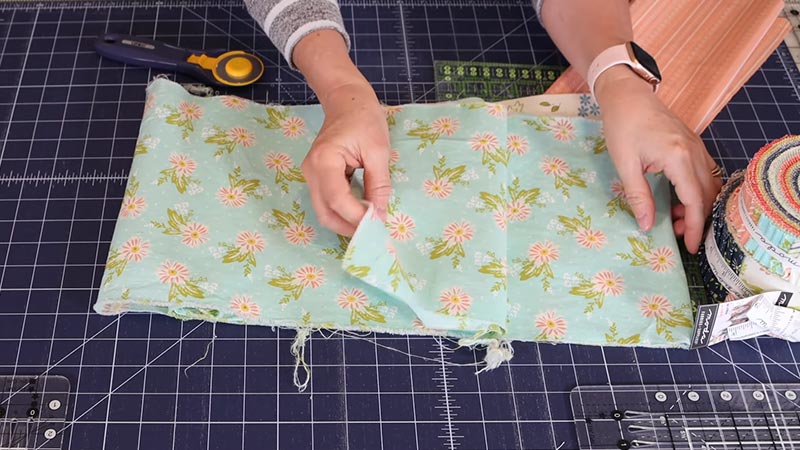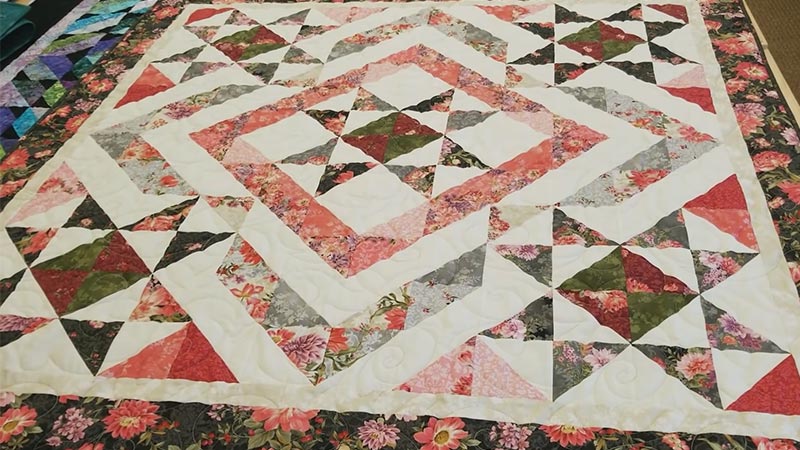Embarking on a quilting project is an endeavor filled with creativity and precision. One often overlooked yet crucial step in this process is prewashing the fabric.
This initial preparation ensures that your quilt remains vibrant, comfortable, and free from potential surprises post-completion.
Prewashing removes sizing, chemicals, and the risk of color bleeding, setting the stage for a quilting masterpiece that stands the test of time.
Understanding the nuances of prewashing, from sorting fabrics to selecting the right water temperature, is essential for quilting success.
In this guide, we’ll delve into the intricacies of prewashing fabric effectively, empowering you to create quilts that are as beautiful as they are enduring.

How to Prewash Fabric for Quilting?
Prewashing fabric is an essential step in the quilting process. It helps remove any sizing, dirt, or chemicals that may be present in the fabric, and it also allows for any potential shrinkage to occur before you start cutting and piecing your quilt.
Here’s a step-by-step guide on how to prewash fabric for quilting:
Materials Needed:
- Fabric to be prewashed
- Mild detergent
- Washing machine
- Dryer or clothesline
- Iron
Sort Your Fabric
Separate your fabrics not only by color but also by type. Different fabrics may have varying care requirements.
For instance, delicate fabrics like silk or satin should be washed separately from sturdier cotton fabrics. By sorting them beforehand, you ensure that each type receives the appropriate treatment.
Check for Colorfastness
To test for colorfastness, dampen a small piece of each fabric and press it against a white cloth. If any color transfers, it indicates that the fabric isn’t colorfast.
Consider washing the fabric separately or using color-catching sheets to prevent bleeding during the wash.
Set Up the Washing Machine
Choose a washing machine with a gentle cycle, if available. Set the water temperature to cold or lukewarm.
Avoid hot water, as it can lead to excessive shrinkage, especially with certain types of fabric.
Add Fabric and Detergent
Load the sorted fabric into the washing machine, ensuring it does not overload. Add a mild detergent specifically designed for delicate fabrics.
Use the recommended amount according to the detergent’s instructions. Too much detergent can lead to residue buildup on your fabric.
Start the Wash Cycle
Initiate the wash cycle and allow it to run its course. Keep an eye on the machine, especially if you’re washing delicate or expensive fabrics.
If any fabric is tangled or stressed, you may want to pause and rearrange the cycle.
Rinse and Spin
After the wash cycle is complete, performing an additional rinse and spin cycle is important. This step helps ensure that all traces of detergent are thoroughly removed, which is crucial for preventing any potential skin irritation or damage to the fabric over time.
Dry the Fabric
You have two options for drying your fabric:
- Machine Dry: If you choose to use a dryer, select a low heat setting. Be sure to check the fabric regularly to prevent over-drying, which can cause excessive wrinkling and make ironing more challenging.
- Air Dry: For a gentler approach, consider air drying. Hang the fabric on a clothesline or flat it on a clean surface. This method minimizes shrinkage and is especially suitable for delicate fabrics.
Iron
After the fabric is dry, you have the option to iron it. Set your iron to a low heat setting, and always iron on the wrong side of the fabric to prevent shine or damage. This step helps ensure your fabric is smooth and ready for cutting and piecing.
Fold and Store
Once your fabric is prewashed and, if desired, ironed, fold it neatly. Store it in a cool, dry place until you can use it in your quilting project.
Proper storage helps prevent dust and wrinkles, ensuring your fabric is in the best condition when you’re ready to start quilting.
Why Prewash Fabric for Quilting?

Prewashing fabric is a crucial step in the quilting process, one that is often debated among quilters. While some choose to skip this step, many seasoned quilters swear by it as an essential practice for several reasons.
Here’s why prewashing fabric for quilting is so important:
Removes Sizing and Chemicals
Fabrics often have sizing substances applied during manufacturing to give them a crisp finish. Prewashing removes this sizing and any chemicals or residues present, ensuring that your quilt is free from potentially irritating substances.
Reduces Color Bleeding
Some fabrics, especially dark or vibrant colors, may bleed during the first wash. Prewashing allows you to identify and address any potential bleeding issues before incorporating the fabric into your quilt.
Prevents Shrinkage
Fabrics can shrink after the first wash. Prewashing helps mitigate this issue, ensuring that your quilted pieces won’t warp or distort after the final assembly.
Checks for Colorfastness
Prewashing also provides an opportunity to test the fabric for colorfastness. This process helps you determine if the fabric’s colors will run or fade over time, allowing you to take appropriate precautions.
Softens the Fabric
Prewashing can make the fabric softer and more pliable. This is particularly beneficial for creating a quilt that feels comfortable and cozy.
Removes Dirt and Dust
When your fabric sits on a shelf or in storage, it may have accumulated dust or dirt. Prewashing ensures that your quilt starts off clean and fresh.
Prevents Uneven Shrinkage
Different fabrics can shrink at varying rates. Prewashing all fabrics together ensures that they will shrink uniformly, avoiding any potential issues with uneven shrinkage once the quilt is assembled.
Enhances Quilting Accuracy
Prewashing can remove any distortions or irregularities that may occur during the first wash. This helps ensure that your quilt pieces maintain their shape and size throughout the quilting process.
Which Fabrics Should You Prewash for Quilting?

It’s generally recommended to prewash most fabrics for quilting, especially natural fibers like cotton, linen, and silk. However, there are exceptions.
Here’s a breakdown of fabrics you should consider prewashing:
Cotton
Prewashing cotton is standard practice in quilting. This process removes any sizing or chemicals applied during manufacturing. It also allows cotton to shrink, preventing distortions in your quilt blocks after assembly.
Additionally, since cotton fabrics often have vibrant colors, prewashing helps prevent any potential color bleeding or transfer in the first wash.
Linen
Prewashing linen is recommended to eliminate sizing, making the fabric softer and more pliable.
Linen can experience significant shrinkage in the first wash, so prewashing is essential to avoid any potential distortions in your quilt blocks down the line.
Silk
Silk is delicate, so prewashing should be approached with care. Use a gentle method like hand washing or a delicate cycle on your washing machine.
Prewashing silk removes any sizing and allows you to check for colorfastness, ensuring your quilt remains vibrant and intact.
Batiks
While batiks are known for their vibrant colors and resistance to bleeding, it’s still advisable to perform a colorfastness test. Some batiks may exhibit slight bleeding in the first wash, making prewashing a wise precaution.
Muslin
Prewashing muslin removes sizing and ensures it’s clean and ready for use as both backing fabric and quilt blocks.
This step ensures your muslin is free from any chemical residues and ready to be incorporated into your project.
Vintage or Repurposed Fabrics
Vintage fabrics can be fragile and may have accumulated dirt or contaminants over time.
Prewashing is crucial to restore them to their best condition. A gentle wash can revive vintage fabrics while ensuring they are clean and safe for use.
Which Fabrics Should You Not Prewash for Quilting?

While prewashing is generally recommended for many quilting fabrics, some exceptions exist.
Fabrics that you typically do not need to prewash for quilting include:
Pre-Cuts
Pre-cut fabric packs like jelly rolls, charm packs, or layer cakes are often treated to prevent fraying. These packs are carefully curated by manufacturers to provide quilters with precisely coordinated fabrics.
Prewashing can undo this treatment and make the fabrics more challenging to work with. Always check the manufacturer’s instructions for guidance on prewashing pre-cut fabrics.
Specialty Fabrics
Fabrics with unique treatments, such as laminated cotton, metallic prints, or fabrics with embellishments like sequins or glitter, may not require prewashing.
Prewashing can potentially damage these special features or alter the fabric’s intended texture and appearance. Always follow the care instructions provided by the manufacturer for specialty fabrics.
Fusible Fabrics
Fabrics with fusible interfacing or backing, often used for appliqué or stabilizing quilt blocks, may not need to be prewashed.
Prewashing can affect the adhesive properties of these fabrics, making them less effective for their intended purpose. Follow the manufacturer’s instructions for fusible fabrics.
High-Quality Batting
High-quality batting materials, such as polyester or cotton batting, typically do not require prewashing.
Batting is sandwiched between quilt layers, and prewashing does not affect its loft and appearance. However, always check the care instructions on the batting packaging to be sure.
Backing Fabrics
The backing fabric for your quilt, especially if it’s wide and will not be pieced together, may not need prewashing. The prewashing backing fabric is often a matter of personal preference and can depend on the specific characteristics of the fabric.
Quilt Panels
When you’re using quilt panels that feature intricate prints or designs, prewashing is generally not necessary.
These panels are often designed to be used as-is, and prewashing may cause the colors to fade or the panel to lose its structure.
Pros and Cons of Prewashing Fabric for Quilting
Prewashing fabric for quilting has its advantages and disadvantages.
Here are the pros and cons to consider:
Pros of Prewashing Fabric for Quilting
- Colorfastness Testing: Prewashing allows you to test the fabric for colorfastness. This ensures that the colors won’t bleed or fade when the quilt is washed in the future.
- Removes Sizing and Chemicals: Prewashing removes any sizing, chemicals, or residues that may be present in the fabric from the manufacturing process. This is especially important for sensitive skin.
- Prevents Shrinkage: Fabrics can shrink after the first wash. Prewashing allows for any potential shrinkage to occur before you start cutting and piecing your quilt.
- Removes Dirt and Dust: If your fabric has been sitting on a shelf or in storage, it may have accumulated dust or dirt. Prewashing ensures that your quilt starts off clean and fresh.
Cons of Prewashing Fabric for Quilting
- Additional Time and Effort: Prewashing adds an extra step to your quilting process, which can be time-consuming, especially if you have a large amount of fabric.
- May Cause Wrinkling: Some fabrics may wrinkle or distort during washing, especially if not handled carefully. This can require extra ironing or pressing.
- Potential Fading: While prewashing can remove excess dye, it may also cause some fabrics to lose a small amount of color vibrancy. This is more likely with certain types of dyes and prints.
- Potential Wear and Tear: Prewashing can lead to fraying or weakening of the fabric edges, especially if they are not properly finished before washing.
Tips for PreWashing Fabric for Quilting
Preparing fabric for quilting through prewashing is important in ensuring a successful and long-lasting project.
Here are some valuable tips to keep in mind:
Sort Your Fabrics
Separate your fabrics by color and type before washing. Wash similar colors together to prevent bleeding. This also helps avoid potential damage to delicate fabrics by washing them separately.
Perform a Colorfastness Test
Before prewashing, test a small swatch of each fabric for colorfastness. Dampen a piece of fabric and press it against a white cloth. If any color transfers, it’s not colorfast, and you should take extra precautions or wash it separately.
Use a Mild Detergent
Choose a mild detergent designed for delicate fabrics. Avoid fabric softeners, as they can leave a residue affecting your quilting later on.
Select the Right Washing Machine Settings
Use a washing machine with a gentle cycle. Set the water temperature to cold or lukewarm. Avoid hot water, as it can cause excessive shrinkage, especially with certain fabrics.
Avoid Overloading the Machine
Don’t overcrowd the washing machine. Overloading can lead to less effective cleaning and potentially damage the fabric.
Use Mesh Laundry Bags
Consider placing smaller or more delicate fabrics in mesh laundry bags to protect them from excessive agitation during the wash.
FAQs
Why is prewashing fabric important for quilting?
Prewashing removes sizing, chemicals, and potential color bleed, ensuring your quilt maintains its appearance and comfort after washing.
Can I skip prewashing if I’m using pre-cut fabric packs?
It’s generally recommended to follow the manufacturer’s instructions. Some pre-cut packs are treated to prevent fraying and may not require prewashing.
How should I test for colorfastness before prewashing?
Dampen a small piece of fabric and press it against a white cloth. If any color transfers, the fabric may not be colorfast, and you should wash it separately.
Should I use hot water for prewashing the fabric?
It’s best to use cold or lukewarm water. Hot water can lead to excessive shrinkage, especially with certain fabric types.
Can I air-dry all fabrics after prewashing?
While air drying is a gentler option, some fabrics may benefit from a low-heat setting in the dryer. Always check the care instructions for specific recommendations.
Wrap Up
Prewashing fabric is a crucial step in preparing for a quilting project. This process removes sizing, chemicals, and potential color bleed, ensuring a quilt’s longevity and appearance. While it may add an extra step, the benefits far outweigh the effort.
Key considerations include testing for colorfastness and using a gentle cycle with mild detergent. Whether air drying or using a low heat setting, proper drying minimizes the risk of shrinkage or damage.
Ultimately, prewashing sets the foundation for a beautiful, long-lasting quilt that will be cherished for years to come. It’s a small investment that pays off in the quality and comfort of the finished piece.
Leave a Reply